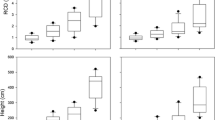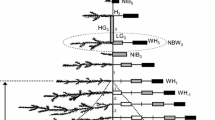Abstract
To determine the growth strategies during early regeneration stages of two major coniferous species (Pinus massoniana and Cunninghamia lanceolata) in a secondary mixed coniferous forest in the Huangshan region of Anhui Province, eastern China, we examined height growth, diameter-height relationship and the relationship between main stem and lateral branch elongation in saplings, with a particular focus on the effects of light intensity and regeneration mode (seedlings versus sprouts). When light intensity was sufficiently high, the extension growth of main stems was greater and more positively related to initial size for P. massoniana than for C. lanceolata. The slenderness of the stem form increased in the following order: C. lanceolata seedlings < P. massoniana seedlings < C. lanceolata sprouts. P. massoniana became less slender with increasing light intensity. P. massoniana had shorter branches than C. lanceolata given the same main stem elongation. Growth allocation depended more strongly on light intensity for P. massoniana than for C. lanceolata, with more growth allocated to the main stem under dark conditions. These results suggest that P. massoniana is a typical shade avoider; this species gives priority to extension growth of the main stem, especially when it is shaded. In contrast, C. lanceolata is a shade tolerator; this species allocates more biomass to radial growth of its main stems and to extension growth of branches. Based on these results, the ecological characteristics of P. massoniana and C. lanceolata and the roles of seedlings and sprouts are discussed in relation to stand dynamics of the mixed forests of P. massoniana and C. lanceolata in eastern China.
Similar content being viewed by others
References
Aphalo P J, Ballare C L, Scopel A L. 1999. Plant-plant signalling, the shade-avoidance response and competition. J Exp Bot, 50(340): 1629–1634
Bellingham P J, Sparrow A D. 2000. Resprouting as life history strategy in woody plant communities. Oikos, 89(2): 409–416
Bond W J, Midgley J J. 2001. Ecology of sprouting in woody plants: the persistence niche. Trends Ecol Evol, 16(1): 45–51
Bond W J, Midgley J J. 2003. The evolutionary ecology of sprouting in woody plants. Int J Plant Sci, 164(3): S103–S114
Del Tredici P. 2001. Sprouting in temperate trees: A morphological and ecological review. Bot Rev, 67: 121–140
Dong M. 1987. Population structure and dynamics of Pinus massoniana Lamb. on Mount Jinyun, Sichuan, China. Vegetatio, 72: 35–44
Frazer G W, Canham C D, Lertzman K P. 1999. Gap light analyzer (GLA), Version 2.0: Imaging software to extract canopy structure and gap light transmission indices from true-colour fisheye photographs, uses manual and program documentation. Millbrook, New York: Simon Fraser University, Burnaby, British Columbia and the Institute of Ecosystem Studies
Gilbert I R, Jarvis P G, Smith H. 2001. Proximity signal and shade avoidance differences between early and late successional trees. Nature, 411: 792–795
Han Y L. 1981. Vegetation of Anhui Province. Hefei: Anhui Science and Technology Publishing House (in Chinese)
He Z M, Yang Y S, Yu X T. 2000. Growth characteristics analysis of seedling and sprouting trees in a second-rotation Chinese fir plantation. J Fujian Coll Forest. 20: 298–301 (in Chinese with English abstract)
Henry H A L, Aarssen L W. 1997. On the relationship between shade tolerance and shade avoidance strategies in woodland plants. Oikos, 80 (3): 575–582
Henry H A L, Aarssen L W. 2001. Inter- and intraspecific relationships between shade tolerance and shade avoidance in temperate trees. Oikos, 93(3): 477–487
Ishida M, Peters R. 1998. Effects of potential PAR on shoot extension in juveniles of the main tree species in a Japanese temperate forest. Ecol Res, 13: 171–182
Ito S. 1992. Dry matter partitioning in seedlings and sprouts of several deciduous broad-leaved tree species, with special reference to the functions of tree architecture. Bull Kyushu Univ Forest, 66: 19–30
Ito S, Yahata H, Suzaki T. 1989. Comparisons of early growth between seedlings and sprouts, and relationship between original tree size and vigor of sprouts of Pasania edulis. J Fac Agr Kyushu Univ, 34: 77–94
Johnson J B, Omland K S. 2004. Model selection in ecology and evolution. Trends Ecol Evol, 19: 101–108
Kennard D K, Gould K, Putz P E, Fredericksen T S, Morales F. 2002. Effect of disturbance intensity on regeneration mechanisms in a tropical dry forest. Forest Ecol Manage, 162: 197–208
Kikuzawa K, Koyama H, Umeki K, Lechowicz M J. 1996. Some evidence for an adaptive linkage between leaf phenology and shoot architecture in sapling trees. Funct Ecol, 10: 252–257
King D A. 1994. Influence of light level on the growth and morphology of saplings in a Panamanian forest. Am J Bot, 81: 948–957
Kobe R K, Pacala S W, Silander Jr J A, Canham C D. 1995. Juvenile tree survivorship as a component of shade tolerance. Ecol Appl, 5(2): 517–532
Kwesiga F, Grace J. 1986. The role of the red/far-red ratio in the response of tropical tree seedlings to shade. Ann Bot, 57: 283–290
Li M, Ritchie G A. 1999. Eight hundred years of clonal forestry in China: I. traditional afforestation with Chinese fir (C. lanceolata lanceolata (Lamb.) Hook.). New Forest, 18: 131–142
Messier C, Doucet R, Ruel J, Claveau Y, Kelly C, Lechowicz M J. 1999. Functional ecology of advance regeneration in relation to light in boreal forests. Can J Forest Res, 29: 812–823
O’Connell B M, Kelty M J. 1994. Crown architecture of understory and opengrown white pine (Pinus strobus L.) saplings. Tree Physiol, 14: 89–102
Oliver C D, Larson B C. 1996. Forest Stand Dynamics-update edition. New York: John Wiley & Sons
Pacala S W, Canham C D, Silander Jr J A, Kobe R K. 1994. Sapling growth as a function of resources in a north temperate forest. Can J Forest Res, 24: 2172–2183
Popma J, Bongers F. 1988. The effect of canopy gaps on growth and morphology of rain forest species. Oecologia, 75: 625–632
Portsmuth A, Niinemets Ü. 2007. Structural and physiological plasticity in response to light and nutrients in five temperate deciduous woody species of contrasting shade tolerance. Funct Ecol, 21: 61–77
R Development Core Team. 2008. R: A language and environment for statistical computing (Version 2.8.1). R foundation for statistical computing, Vienna, Austria. URL http://www.R-project.org/. (accessed July 01, 2010)
Saeki I. 2010. Juvenile sprouting ability of the endangered maple, Acer pycnanthum. Landscape Ecol Eng, 6: 1–9
Sakai A. 1997. Ecological signifi cance of sprouts tree species-sprouting characteristics as a strategy of life history. Shuseibutugaku Kenkyu, 21: 1–12 (in Japanese)
Sakai A, Sakai S. 1998. A test for the resource remobilization hypothesis: tree sprouting using carbohydrates from aboveground parts. Ann Bot, 82: 213–216
Smith D M, Larson B C, Kelty M J, Ashton P M S. 1997. The Practice of Silviculture: Applied Forest Ecology. New York: John Wiley & Sons
Sun C. 1992. Community forestry in southern China. J Forest, 90: 35–40
Umeki K, Kikuzawa K, Sterck F J. 2010. Influence of foliar phenology and shoot inclination on annual photosynthetic gain in individual beech saplings: A functional-structural modeling approach. Forest Ecol Manage, 259: 2141–2150
Van der Heyden F, Stock W D. 1996. Regrowth of a semiarid shrub following simulated browsing: the role of reserve carbon. Funct Ecol, 10: 647–653
Vesk P A, Westoby M. 2004. Sprouting ability across diverse disturbances and vegetation types worldwide. J Ecol, 92: 310–320
Walters M B, Reich P B. 1996. Are shade tolerance, survival, and growth linked? Low light and nitrogen effects on hardwood seedlings. Ecology, 77: 841–853
Wu X, Sun Z, Gao L. 2006. Forestry in Qimen County. Qimen, Anhui: Forestry Bureau of Qimen County (in Chinese)
Wu Z L. 1984. Chinese-fir. Beijing: China Forestry Publishing House (in Chinese)
Zhang P, Shao G, Zhao G, Le Master D C, Parker G R, Dunning Jr J B, Li Q. 2000. China’s forest policy for the 21st century. Science, 288(5474): 2135–2136
Zhou Z X. 2000. Masson pine in China. Beijing: China Forestry Publishing House (in Chinese with English abstract)
Author information
Authors and Affiliations
Corresponding author
Rights and permissions
About this article
Cite this article
Cheng, Xp., Kiyoshi, U., Tsuyoshi, H. et al. Height growth, diameter-height relationships and branching architecture of Pinus massoniana and Cunninghamia lanceolata in early regeneration stages in Anhui Province, eastern China: effects of light intensity and regeneration mode. For. Stud. China 13, 1–12 (2011). https://doi.org/10.1007/s11632-011-0104-z
Received:
Accepted:
Published:
Issue Date:
DOI: https://doi.org/10.1007/s11632-011-0104-z




